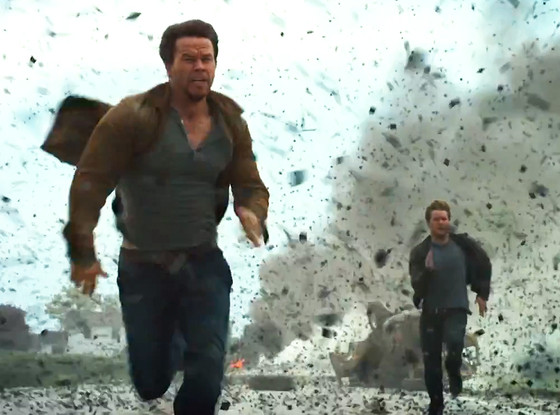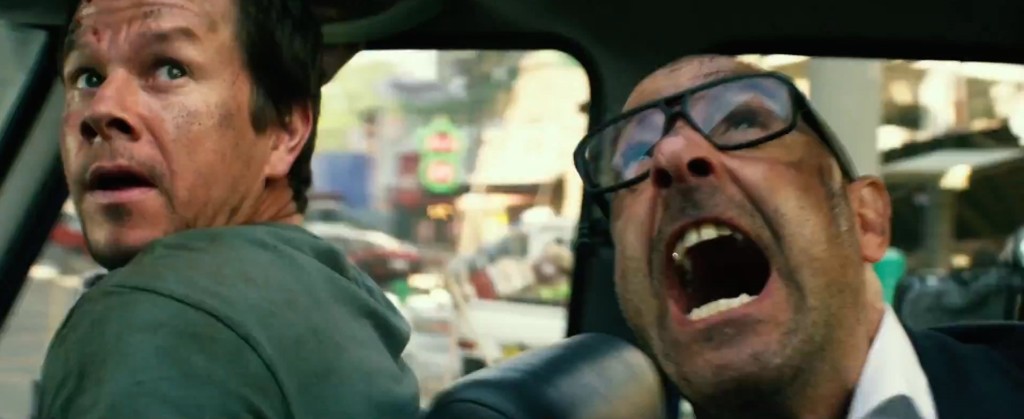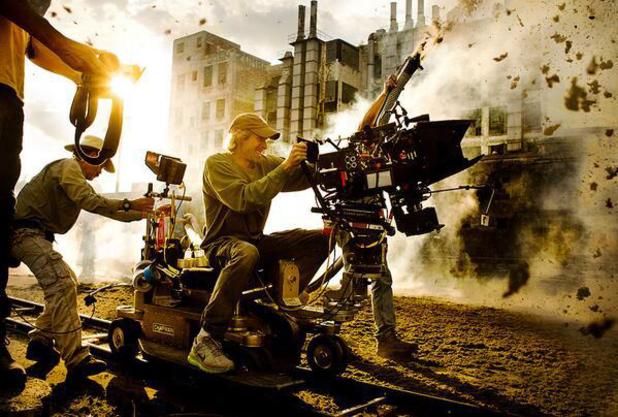
Optimus Prime riding a giant robot dinosaur. (Source)
I learned something about Michael Bay while watching his latest opus, Transformers: Age of Extinction.
Michael Bay will never be a great filmmaker, but he’s a real mensch. Particularly to fans of the multi-billion dollar property that has been entrusted to him.
So why do we, in general, hate him so roundly? Well, aside from the fact that we hate everything, and the fact that we remain faintly embarrassed that our standard-bearer is a slummin’ it overpaid Bay as opposed to an artiste like Christopher Nolan or Ridley Scott or Jim fuckin’ Jarmusch, we in fact hate him because he’s always trying to chase after what he thinks we want, and he never quite gets there. What’s worse, this fruitless tilting at the desires of the fandom makes the movies feel even more like the produced-by-committee Hollywood behemoths that they are.
Take Transformers: Revenge of the Fallen, a critical disaster that squandered the goodwill created by the better-than-it-had-a-right-to-be first Transformers movie. The fan critiques of the first film, which tend to resonate at Hasbro, were along the lines of “there weren’t enough robots,” “the movie was too small in scale,” and “not enough references to the mythology.” RotF made sure that there were plenty of robots, plenty of worldwide destruction, plenty of Primes, plenty of Matrix. But in treating the symptoms, the production team didn’t catch the disease, which was that they didn’t truly understand the Transformers. Cramming in everything they thought we wanted resulted in an overstuffed movie, and the 2009 Writer’s Guild strike was the deathblow. The result was perhaps the biggest mismatch of box office returns (from people expecting a good followup to TF1) to reported quality in recent big-budget history. This movie is the poison pill that made thousands swear to never again watch a Bay film.
The scramble to fix RotF led to Transformers: Dark of the Moon, which certainly is a far superior effort. The criticisms the production team attempted to address were as follows: “too predictable,” “too lightweight/low stakes,” “not enough popular villains,” “incoherent plot.” The result was a film with a strong character-focused plotline, a vicious second-act twist, and Independence Day-levels of death and destruction. However, the disease still survived. The camera and script still could not decide whether to treat the Transformers as props or as characters, resulting in the odd spectacle of alien robots treating other members of their own species as soulless monsters to be disposed of. And the use of nearly every popular Decepticon in the Hasbro stable proved problematic when the plot dictated that they all be killed unceremoniously in the third act. Finally–because most of the fans don’t yet realize that this IS a problem–the movie is perhaps even more ludicrously overstuffed than RotF. I’ve counted nearly a hundred instances of planting and payoff in that script, and dozens of Hasbro easter eggs, but they blow by so fast that they cannot be noticed.

Bay’s Pain & Gain star Mark Wahlberg subs in for Shia LeBeouf in this installment. (Source)
Today we have Transformers: Age of Extinction. This is possibly the most fanservice-filled movie yet, the result of the increasingly rarified audience that any four+ film franchise can expect. That means that as a hardcore Transformers fan (who’s not of the knee-jerk hate-the-movies subspecies) I had a HELL of a good time. But my wife, who’s greatly enjoyed some of the previous installments, did not. They’ve treated more of the symptoms than ever before, but they are still left with the disease, now compounded by fatigue with getting movie after movie in Michael Bay’s exhausting style.
The two fatal flaws in this movie are familiar ones. First of all, it’s still overstuffed. There are about three lean, mean plots presented here that are all crammed into one film and cemented together by Transformers references and uneven humor. Second, despite all that cramming, the movie is an exhausting three hours even. That’s unacceptable. The storytelling, while serviceable, does not support that length. Whole characters exist only to eat up runtime and accomplish nothing. As usual, we get lengthy “leave the camera running and let the actors freak out” scenes that aren’t entertaining enough to exist.
However, for those who are prepared to endure the film’s structural flaws and Bay’s sexist camera (the panty shots seem almost bored and perfunctory this time, again, as if he’s giving us what he thinks we actually want), there is a lot of good stuff here. This movie focuses more on Optimus Prime than any other in the franchise, forcing him to witness the unspeakably gruesome fate of one of his closest friends. The deaths of the Autobots and the disfiguring wounds given to Prime are the result of a double betrayal: that of a calculating military-industrial complex, and of a traumatized, indifferent mass of US citizens. The neglect of the latter enables the malice of the former. One thing you have to give these movies, they are not afraid to confront the zeitgeist.
Kelsey Grammer’s character, a sneering Dick Cheney stand-in, makes a deal with Cybertronian bounty hunter Lockdown. Lockdown, a transplant from Transformers Animated, is a highlight of the film, elegant, brilliant, and ruthless. He’s everything the fans wanted to see from the Decepticons of the previous three films, who came off as mindless brutes. Lockdown wants just one thing: Optimus Prime. Grammer sells out Prime for a MacGuffin that Stanley Tucci’s oily inventor can use to make them both rich. Tucci runs a group that is dissecting dead Decepticons and melting them down to build new ones for the US to use as drones. When Prime evades Lockdown’s ambush, Grammer simply adds the Autobots to the kill list to draw him out into the open.
Prime unwittingly ends up the property of Mark Wahlberg’s character. Wahlberg starts off as a “useless inventor” stock character. He’s at his best when circumstances force him to become an action hero in the vein of Prime himself, and the two of them enable each others’ arcs of becoming less cynical and more proactive. He’s at his worst for the bulk of the time he is on screen, playing an overprotective dad and bitching at his daughter’s boyfriend in a reheated plotline from Bay’s own Armageddon.
Tucci also whipsaws between fantastic and unbearable, starting off as a humorous villain (he tortures a living Autobot and desecrates dead ones) and somehow ending up as a reluctant hero. While he’s entertaining, and his redemption is evocative for Prime’s realization that humanity’s not all bad, he’s never made to pay for what he’s done.

Stanley Fucking Tucci. (Source)
This defangs the film’s central message, which is an altogether well-considered response to the problems of the first three films. Transformers is an enduring property because while its protagonists look like robots, they are actually living beings. Earlier, Bay’s films paid lip service to this, but in practice they treated Autobots and Decepticons alike as disposable automatons. Ironhide and Jazz don’t get so much as a funeral, helpless Decepticons are dispatched as if they are vermin instead of enemy soldiers, and even Prime himself is filmed and treated as if he were so much wreckage when he spends part of RotF dead. In a weird attempt at overcompensation, the Transformers started bleeding, farting, drooling, and blubbering around movie 2–a strange conflation of “organic robot” with “living robot.”
This movie reverses course and plunges right into the nature of Transformer life, re-establishing the old franchise saw that a “spark” is a Transformer’s “soul.” Wahlberg and Optimus’ discussion of this topic sets up the movie to explore a little later the nature of a Transformer without a soul, which, of course, is exactly what Grammer and Tucci build. There is a memorable scene where the Autobots confront Tucci, horrified beyond belief at the atrocities they see around them, only to be cut short by Tucci’s firm belief that he has done nothing more than melt down and re-purpose some machines. This feels very much like Bay and screenwriter Ehren Kruger taking themselves to task. Tucci’s abuse of the Transformers has devastating consequences in the third act, which makes this movie more enlightened on the subject of torture than Zero Dark Thirty is.
The betrayal of the Autobots allows this movie to take down the almost manic insistence of Optimus to protect every last human, which he has held in the previous films. Optimus doesn’t need such a cartoonish sense of morality in order for us to accept him as a hero. If the Transformers are people just like us, then we need to take responsibility for our crimes just the same as they must. One of the best pieces of CGI “acting” in this movie is done with Optimus, without even the benefit of Peter Cullen’s masterful voice. He realizes that he’s going to have to flatten about a dozen government agents in order to save an innocent life, and after a moment’s hesitation, he goes and damn well does it.
Remember how I said the movie was overstuffed? I’ve still barely scratched the surface. The Autobot squad is a highlight, with the returning Bumblebee playing straight man to an entertaining crew of violent idiots. Ken Watanabe, John Goodman, and John DiMaggio are all comic treasures, and all get a chance to emote and to kick ass. The “twist” in this movie is a memorable one and features the return of a fan-beloved voice actor in epic fashion. Finally, there are three very tantalizing plot threads left out for future films, or perhaps comics if the money train runs out of steam with this installment.
Unfortunately, the marketing darlings of the film, the Dinobots, get just as short shrift in the film as they do in this review. A very undercooked last-minute plotline revolves around “Knights” that Lockdown has been capturing. One of them, for god only knows what reason, is Optimus Prime. The others are the four Dinobots. On the plus side, they are ancient warriors, as opposed to the original show’s hastily-built dumb muscle. However, they never learn English, and the script doesn’t bother to explain why Optimus has to beat the absolute piss out of Grimlock and threaten him in order to secure the Dinobots’ aid. Perhaps worst of all, the Dinobots’ introduction scene takes place during the extended climactic sequence, which criminally throws off the pacing. Optimus is having a meet cute while some of his allies are surrounded and moments from death.
Overall, I’d say that this film is a hoot, which is all I feel I can reasonably expect from The Fourth Transformers Movie by Michael Bay. Bay had his chance to leave the franchise on a high note after Dark of the Moon. He now has another one. I’m afraid he may not get any more. If there’s one thing that Transformers fandom and the general public do agree on, it’s that it’s time for the aggressively mixed blessing that is Michael Bay to bow out. We know he’s trying, but if he’s really a mensch he’ll give a fresh voice a shot for TF5.

It’s time for the Bayhem to come to an end. (Source)
Transformers: Age of Extinction is in theaters now.

